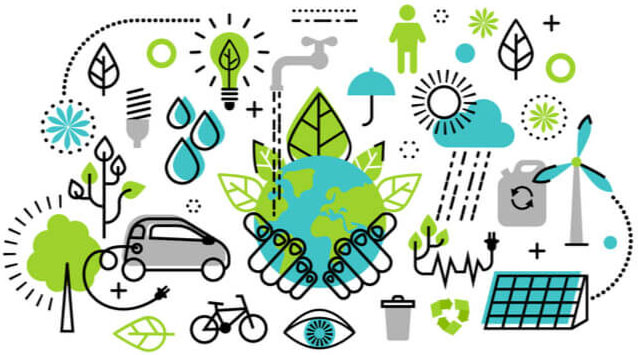
Green energy: What it is and how it works
Green energy comes from sources that cause little-to-no impact on the world’s carbon footprint. Most scientists agree today that the world is getting warmer, in large part due to the production of carbon dioxide.
Green energy sources such as geothermal, solar, wind, hydro, and some biomass can be used to generate electricity without producing much, if any, carbon dioxide. That’s in contrast to fossil fuels such as coal, oil, and even natural gas.
Texas has a very strong command of renewable energy, excelling at wind and solar generation. The state’s electricity rates are well below the national average. Accordingly, more Texans are looking favorably at green energy plans and how they can help the environment.
Renewable energy sources
Green energy and renewable energy often are used interchangeably, but the terms aren’t the same. All green energy sources of power are renewable, but certain renewable energy sources are not green. For example, burning wood to produce electricity generates carbon dioxide. So, while wood is renewable, many scientists debate whether it is truly green.
Similar arguments can be made about other green energy sources. Solar energy panels aren’t necessarily green. Wind turbine blades can stay in landfills long after they’ve been used. Hydro energy can damage the environment by destroying habitats.
But for now, let’s concentrate on green energy sources, including biomass, that can reduce dependence on fossil fuels.
Geothermal energy
Geothermal energy uses hot water and steam that come from underground reservoirs. It can reach as far as the magma layer of the earth. Power plants using this type of energy convert the heat and steam and use it to drive a turbine, which produces electricity.
The U.S. is the world’s largest producer of electricity from geothermal energy. However, Texas is considered an untapped resource when it comes to geothermal. The Energy Information Administration says billions of barrels of water as hot as 200 degrees are produced annually as part of crude oil and natural gas production and could be used in geothermal generation.
Solar energy
Solar energy is a small but growing part of the nation’s energy puzzle, producing about 3 percent of the electricity generated in November 2020, the most recent month available from the EIA. Most people have seen solar panels on rooftops or in the large solar “farms” mostly in rural settings, but few know how they work.
Basically, the panels act as semiconductors, with positive and negative layers. A conductor attached to both layers creates an electric circuit and turn electrons from sunlight into electricity. There are other steps that convert it for home use.
Texas generated the second-most electricity by solar means in November (behind California). The Texas generation was the 8.1 percent of the nation’s total.
Wind energy
With all due respect to the sun, wind energy is where Texas shines. The state was responsible for more than 24 percent of the nation’s electricity generation by wind in November. That was more than twice as much as any other state.
Wind, in general, accounted for more than 11 percent of the nation’s energy that month.
Here’s how it happens: Wind causes the huge turbine blades to spin, causing a rotor inside to turn as well. The rotor in turn is hooked up to a generator, which turns the motion of the rotor into electricity.
Hydro energy
Electricity generated by hydroelectric projects accounted for 7.3 percent of the country’s electricity in November. Washington state got more than 60 percent of its electricity from hydro means in November.
Dams are the key component for this form of green energy. The dams allow hydroelectric plants to channel water through turbines, again feeding generators that turn the kinetic energy into electricity.
Texas has more than 20 hydro plants, but they contribute less than 1 percent to the state’s electricity generation.
Biomass energy
Biomass is organic material from plants and animals. The material can be burned as is or converted to liquid or gas biofuels. Examples of biomass include wood, other plants, and wastes. Wood and ethanol make up the largest energy sources of biomass, which produces about 5 percent of the country’s energy.
Biomass produces less than 1 percent of Texas electric generation, with most of that coming from wood.
FAQs about green energy
If I get a 100 percent green energy plan, does that mean green energy is delivered to my house?
No, it means your provider will purchase renewable energy credits equal to 100 percent of your usage. This means that amount of green energy is delivered to the electric grid, where it mixes will other forms of energy.
Does renewable energy cost more than other types of energy?
Costs are competitive and getting moreso. According to a 2019 report from the International Renewable Energy Agency, new generation techniques for solar and onshore wind plants have lowered costs to 6.8 cents per kilowatt hour (kWh) and 5.3 cents/kWh, respectively. The cost of generating electricity from fossil fuels ranged from 5 cents/kWh to 17 cents/kWh, it said.
Does green energy have harmful effects on the environment?
Some does. Production of solar panels uses some toxic metals. Dams used in hydroelectric generation can cause flooding and negatively affect wildlife habitat. Wind turbines have been blamed for bird and bat deaths, and the giant turbine blades, when no longer useful, can lie for years in landfills. Biomass, as mentioned, produces carbon dioxide when burned.
How to get a green energy plan
Renewable energy is part of every Texas energy plan. The percentage of renewable energy can be found on a plan’s Electricity Facts Label. Most retail electric providers in Texas also offer plans with higher percentages of green electricity, including plans that are 100 percent green.
Some providers only sell 100 percent green energy. Among those are Iberdrola Texas, Gexa Energy, Green Mountain Energy, and Chariot Energy.
Source: save on energy l KeyFacts Energy: Renewable Energy news
 KEYFACT Energy
KEYFACT Energy
